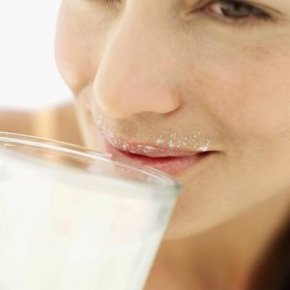
 Acidophilus milk has "good" bacteria added in.
Acidophilus milk has "good" bacteria added in.
Kefir and acidophilus milk both consist of regular milk to which “good” bacteria, or probiotics, are added. Probiotics are identical to or similar to the beneficial bacteria found naturally in the human body. There’s strong evidence that probiotics are useful in treating diarrhea, and they show potential for treating a number of other conditions, including irritable bowel syndrome, eczema and tooth decay, according to the National Center for Complementary and Alternative Medicine.
Cultures
Kefir and acidophilus milk both contain live cultures, but vary quite a bit in which bacteria and how many they contain. Acidophilus milk contains Lactobacillus acidophilus. It may also contain Bifidobacterium bifidum, a probiotic that’s also found in yogurt. Kefir may contain anywhere from 10 to 20 or more beneficial bacteria, including several different strains of Lactobacilli, according to an article in the "Food Science and Technology Bulletin." It also contains yeasts.
Flavor and Texture
Kefir and acidophilus milk have very different flavors and textures. Kefir is tangy, like yogurt, and has the consistency of a milkshake. Traditional kefir, which may be made from cow’s, sheep’s or goat’s milk, is slightly fizzy. Sweet, or unfermented, acidophilus milk closely resembles regular milk in flavor and texture. Fermented acidophilus milk is a bit tangier and thicker than regular milk. Kefir also comes in a variety of flavors, like yogurt, while acidophilus milk is usually sold plain.
Nutrition
Both kefir and acidophilus milk have the same nutrition profile as the milk they’re made from. Unflavored acidophilus milk or kefir made from 1 percent milk has 120 calories, 2.5 grams of fat, 10 milligrams of cholesterol, 12 grams of sugar and 8 grams of protein, and provides 10 percent of the U.S. Food and Drug Administration's daily value for vitamin A, 30 percent of the DV for calcium and 25 percent of the DV for vitamin D. Flavored, sweetened kefir has more calories and sugar.
Lactose
Lactobacillus acidophilus may not have much effect on lactose intolerance, according to MedlinePlus. Fermented dairy products such as kefir often contain less lactose than fresh dairy products. In a small study published in the "Journal of the American Dietetic Association, " kefir reduced symptoms in lactose-intolerant participants. The researchers recommended further studies of kefir's effects on lactose intolerance.
YOU MIGHT ALSO LIKE












